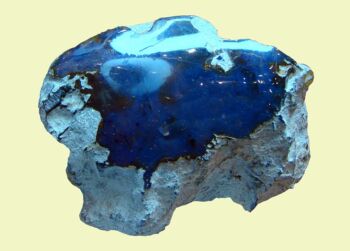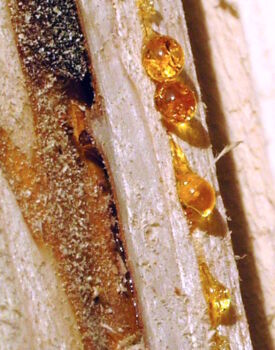This mysterious material was widely used by ancient cultures. This soft material was ideal for being cut and carved into precious gems and jewellery.

Image source: https://en.wikipedia.org/wiki/Amber#/media/File:Bernstein_Bitterfeld,_Gedanit,_Bruchst%C3%BCcke_5658.jpg
What Is Amber?
Amber is the fossilized resin of trees and was cut and shaped since Neolithic times to create jewelry and other decorative objects, or as a healing agent. Amber has a unique paleontological significance because sometimes this material can preserve unfossilizable parts of plants and animals. The major source of this material was the Baltic region where amber, was thrown up on shores by the weaves, and easily collected by the inhabitants. It was believed that this material had magical qualities such as protecting the wearer, warding off evil, and curing diseases. As the usual color of amber is yellow, orange, or brown, this translucent material can occur in a range of different colors: pale lemon yellow, black, green, and blue (its rarest, most valuable version, only found in the Dominican Republic).

Image source:https://en.wikipedia.org/wiki/Amber#/media/File:Ambre_bleu_dominicain_21207.jpg
A Mysterious Power
Amber is a relatively soft material and so was shaped into jewelry. It was collected and washed on Northern European beaches. Due to its softness, the material is susceptible to degradation, and if exposed to air for long the material fade over and becomes opaque. Ancient people were fascinated by the unusual properties (for example the attraction when rubbed) and the mysterious origin of this material and believed that amber had mystical properties. Considered capable of protecting the wearer from evil and disease, it was an apotropaic amulet in ancient Egypt and Greece. Moreover, amber was believed to have healing powers: in Roman cemeteries, for example, child burials contained amber beads which were likely placed there to function as amulets. Pliny suggests in his Natural History that some people believed amber could help with problems connected to the tonsils, mouth, and mental disorders. Sometimes it was finely ground and mixed with rose oil and honey to treat infections. However, these beliefs were not so unrealistic because amber contains a natural antibiotic known as succinic acid. Even today, Traditional Chinese medicine uses amber to “tranquilize the mind”.

Image source: https://en.wikipedia.org/wiki/Amber#/media/File:Gouttes-drops-resine-2.jpg
From Neolithic Period to Nowadays
The earliest amber workshops in the Baltic were dated back to the Neolithic period. Commercial contacts between ancient communities ensured the trading of amber around Europe, thanks mainly to the central European tribes and the seafaring civilizations. Because of its rarity, the material was particularly prized in the East where it was largely reserved for royalty or priests (found in Egyptian tombs). In ancient China, for example, amber was being burned during large festivities. If heated the amber produces an oil, which releases a fresh “pinewood” fragrance. Amber was common in Archaic Greek, and Etruscans started jewelry production and other goods, such as human or animal figures. During the Roman Empire amber was prized and fashionable again, imported from northern Europe, was used to make jewelry largely worn by Roman women, figurines or small containers, and goblets. Amber usage declined from the 3rd century AD, but thanks to Armenian manufacture, its use has come down to us.

Image source: https://en.wikipedia.org/wiki/File:Amber.pendants.800pix.050203.jpg
Info source:
https://www.getty.edu/publications/ambers/intro/4/
https://www.ancient.eu/Amber/ https://en.wikipedia.org/wiki/Amber#History
